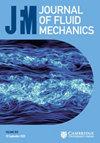Double diffusive convection in the diffusive regime with a uniform background shear
IF 3.9
2区 工程技术
Q1 MECHANICS
引用次数: 0
Abstract
This study proposes a new mechanism that can lead to layering or convection from the finite amplitude perturbation acting on the double diffusive convection with uniform background shear. We focus on the double diffusive convection in the diffusive regime with the cold fresh water laying above the warm salty water. We demonstrate that, although the unperturbed system is linearly stable, the finite amplitude perturbation can trigger the initial flow motions which subsequently obtain energy from the gravitational potential energy and from the uniform background shear, and evolve to layering or convection. By using the linear stability analysis for the initial growth stage and the energy analysis for the following transitional stage, the critical Richardson number can be predicted theoretically. Here the Richardson number measures the relative strength of stratification to the background shear. The dominant wavenumbers and the growth rates of the corresponding modes given by linear theory agree well with the two-dimensional direct numerical simulations, and so does the critical Richardson number predicted by the theoretical model. The layering state is dominated by the double diffusion process, while the convection state at smaller Richardson number exhibits stronger influences from shear and generates smaller heat and salinity fluxes. The theoretical model is further applied to the parameter range which is relevant to the real oceanic environments and reveals that for the typical density ratio observed in the staircase regions in the Arctic Ocean, the current mechanism can lead to layering for relatively weak shear.具有均匀背景剪切力的扩散系统中的双重扩散对流
本研究提出了一种新机制,它可以通过作用于均匀背景剪切的双扩散对流的有限振幅扰动导致分层或对流。我们重点研究了扩散机制下的双重扩散对流,即冷淡水位于暖咸水之上。我们证明,尽管未受扰动的系统是线性稳定的,但有限振幅扰动会引发初始流动运动,随后从重力势能和均匀背景剪切力中获得能量,并演变为分层或对流。通过对初始增长阶段的线性稳定性分析和随后过渡阶段的能量分析,可以从理论上预测临界理查德森数。这里的理查德森数衡量的是分层与背景剪切的相对强度。线性理论给出的主导波数和相应模式的增长率与二维直接数值模拟结果非常吻合,理论模型预测的临界理查德森数也是如此。分层状态由双重扩散过程主导,而较小理查德森数下的对流状态受剪切力影响较大,产生的热通量和盐度通量较小。理论模型进一步应用于与实际海洋环境相关的参数范围,结果表明,对于在北冰洋阶梯区观测到的典型密度比,当前机制可在相对较弱的剪切力作用下导致分层。
本文章由计算机程序翻译,如有差异,请以英文原文为准。
求助全文
约1分钟内获得全文
求助全文
来源期刊
CiteScore
6.50
自引率
27.00%
发文量
945
审稿时长
5.1 months
期刊介绍:
Journal of Fluid Mechanics is the leading international journal in the field and is essential reading for all those concerned with developments in fluid mechanics. It publishes authoritative articles covering theoretical, computational and experimental investigations of all aspects of the mechanics of fluids. Each issue contains papers on both the fundamental aspects of fluid mechanics, and their applications to other fields such as aeronautics, astrophysics, biology, chemical and mechanical engineering, hydraulics, meteorology, oceanography, geology, acoustics and combustion.

 求助内容:
求助内容: 应助结果提醒方式:
应助结果提醒方式:


